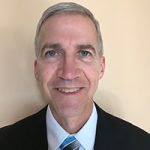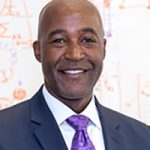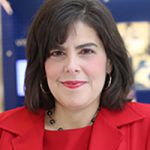Mark Otto and Gary Sullivan
At the 2017 Joint Statistical Meetings, four statisticians representing government, the business/private sector, and academia participated in a panel discussion, “The Leadership Journey for Statisticians,” organized and chaired by Gary Sullivan. Panelists shared their perspectives and experiences regarding the importance of leadership for statisticians and how leadership skills are developed. Here are excerpts from that discussion. In addition, 2018 ASA President Lisa LaVange shares thoughts about her planned leadership initiative.

Gary Sullivan recently retired from Eli Lilly and Company, a major pharmaceutical research and manufacturing company, where he was the senior director for nonclinical statistics. He is the chair of the ASA’s Ad Hoc Leadership Training Committee.
 Nancy L. Geller is director of the Office of Biostatistics Research at the National Heart, Lung, and Blood Institute of the National Institutes of Health, where she directs a group of 12 statisticians. She is a Fellow of the American Statistical Association and was ASA president in 2011.
Nancy L. Geller is director of the Office of Biostatistics Research at the National Heart, Lung, and Blood Institute of the National Institutes of Health, where she directs a group of 12 statisticians. She is a Fellow of the American Statistical Association and was ASA president in 2011.
 F. DuBois Bowman is chair of the department of biostatistics in the Mailman School of Public Health at Columbia University and the Cynthia and Robert Citrone – Roslyn and Leslie Goldstein Professor of Biostatistics. He is a Fellow of the American Statistical Association and has served as president of the Eastern North American Region (ENAR) of the International Biometric Society.
F. DuBois Bowman is chair of the department of biostatistics in the Mailman School of Public Health at Columbia University and the Cynthia and Robert Citrone – Roslyn and Leslie Goldstein Professor of Biostatistics. He is a Fellow of the American Statistical Association and has served as president of the Eastern North American Region (ENAR) of the International Biometric Society.
 Bob Rodriguez is a senior director at SAS Research and Development with responsibility for the development of statistical software. He earned his PhD in statistics from The University of North Carolina. Rodriguez is a Fellow of the American Statistical Association and served as ASA president in 2012.
Bob Rodriguez is a senior director at SAS Research and Development with responsibility for the development of statistical software. He earned his PhD in statistics from The University of North Carolina. Rodriguez is a Fellow of the American Statistical Association and served as ASA president in 2012.
 Stacy Lindborg is the vice president of biometrics at Biogen, one of the world’s leading biotechnology companies. She has a PhD in statistics from Baylor University and more than 20 years of experience in the pharmaceutical industry. She is a Fellow of the American Statistical Association and has held multiple elected positions with the ASA and International Biometric Society, Eastern North American Region.
Stacy Lindborg is the vice president of biometrics at Biogen, one of the world’s leading biotechnology companies. She has a PhD in statistics from Baylor University and more than 20 years of experience in the pharmaceutical industry. She is a Fellow of the American Statistical Association and has held multiple elected positions with the ASA and International Biometric Society, Eastern North American Region.
What Is Leadership?
GARY: One definition of leadership is the ability to inspire people to take a specific direction or action when they truly have the freedom of choice to do otherwise. Will you start by saying a few words about your experiences and perspective on the importance of leadership development for statisticians … or your first realization of the importance of leadership?
STACY: My first realization of the importance of leadership came when I found myself asking how can I be more involved? Ask yourself what do you want to do or what are you passionate about. How do you want to commit your time and energy? You cannot lead if you do not have that passion and take that first step.
BOB: Leadership development—gaining the ability to influence others—is critical for statisticians, because collaborating with people in other fields is a fundamental aspect of our work. Few statisticians enter their careers intending to become leaders. I certainly didn’t, and I was unprepared for my first management assignment. However, as I have learned over time, statistical leadership does not come with a title; it is emergent, rather than assigned. You become an emergent leader by recognizing a problem that matters to your organization, moving to the middle of the situation, and influencing others to accomplish a common goal. Statisticians who can do this are increasingly valued in today’s data-driven organizations, and so we should all be prepared to become leaders.
As the panelists shared, there are many paths for leadership development and many opportunities for statisticians to lead. The topic of statistical leadership has received an ever-increasing amount of attention within our profession in recent years, including courses, sessions, panel discussions, and webinars. As stated so well by 2012 ASA President Bob Rodriguez, “Leadership ability is a prerequisite for the growth of our field because statistics is an interdisciplinary endeavor and our success ultimately depends on getting others to understand and act on our work.” The journey starts with becoming a student of leadership and encouraging others to do the same!
DUBOIS: Leadership is a skill. Skills can be developed. We may each possess an aptitude for certain aspects of leadership, but we are all capable of working to become more effective leaders. A common model for academic leadership is to find individuals who have been successful researchers and educators, and then recruit them to be leaders. Success largely rests upon what one can learn from on-the-job training! This is clearly not an optimal model for building effective leaders.
There are an increasing number of opportunities to advance one’s leadership skills through formal courses, workshops, or reading, and I highly recommend them. The first such course I took was while I was at an early career stage, transitioning from an assistant to associate professor. I found the experience to be enlightening, and it helped to orient my thinking toward leadership, to expand my leadership and management skills, and to expand my network by connecting me to other current and emerging leaders at the institution.
NANCY: I always had role models … my mother was a role model. I also took on leadership roles as early as when I was a junior counselor at day camp. I took on leadership roles starting in high school and on into college. My mother was always there (figuratively). Gestalt workshops helped. I was acting head at Sloan-Kettering, but didn’t get the real position. Nevertheless, I kept on persevering.
GARY: Can each of you talk about some leadership characteristics or competencies that are especially important to develop if one is to become a statistical leader?
NANCY: Eye contact is important. … Do you know what the difference is between a mathematician and a statistician? The statistician looks at your shoes when (s)he talks! It’s important to read body language and communicate effectively. You also need to be able to explain statistical concepts in layperson’s terms.
DUBOIS: Lead from a position of principles, driven by strong moral and ethical standards. Simply stated, try to do the right thing. I select this competency because, in many ways, it allows us to tap into skills that are very natural to us as statisticians. If you can approach leadership issues from a perspective of principles, then the path toward a solution can almost be approached in the same manner you would approach a research problem or statistical analysis.
Our training equips us with skills to listen, frame a problem, gather and synthesize information, analyze available data, make decisions informed by data, and communicate decisions effectively back to stakeholders. As statisticians, we often find ourselves the member of a research team helping to ensure rigor and maintain scientific integrity. This position enables us to proceed in a relatively objective and unbiased way. Similarly, leading from principles with high ethical standards allows us to have conviction that we are doing the right thing, regardless of who falls into the winners and losers columns, even, in some cases, if you happen not to benefit directly from a decision. Ultimately, this approach generates respect from colleagues and your principle-based leadership may deliver, rather than agenda-based leadership.
BOB: Business savvy is a critical competency. It means knowing the needs of your customers (internal or external) and understanding the processes by which things get done in your organization. It also means speaking the language of the business and applying metrics used by decision-makers. Another name for business savvy is organizational understanding, and it is a must for statistical leaders in any sector. For instance, as a newly elected vice president of ASA in 2005, I realized I had much to learn about the operation of the board of directors. I turned to one of our former presidents, Bob Mason, who painstakingly explained the board’s structure and functions. The insights I gained from Bob substantially benefited my subsequent work on the board.
STACY: Have humility when you step into leadership roles. Understand the business from different levels and expertise. With a humble attitude, you are open to listening and learning. It gives you the ability to create an environment with more trust. One should not be discouraged by failures or setbacks, but instead use them as opportunities to look more closely at what went wrong and how you can learn. Let me give an example.
When I was at Eli Lilly, I took a leadership role outside my comfort zone as head of R&D strategy and decision sciences. Early in my role, I was networking, collaborating, listening, motivating areas of transformation—in short, I thought I was rocking my role! In a regular 1:1 meeting, my boss looked at me and asked, “How are we going to help you be successful?” I didn’t even know I wasn’t focusing on what they were seeking. This question was so incredibly helpful and crucial to my success. To be successful, I had to step back and explore what the focus of my role should be, seeking different perspectives.
AUDIENCE: How do you identify and pursue the right opportunity?
STACY: Early in my career, I turned down a few administrative jobs, opting to focus on technical roles. I ultimately took my first administrative position because it provided the opportunity to influence the entire early-phase portfolio. I could help translate areas that needed transformation (statistical innovation) across the whole early portfolio versus the much slower approach of motivating change one team at a time. Our focus could align our organization with what we saw as opportunities and drastically speed up the adoption rate.
But it doesn’t take an administrative, or even a big, role to grow as a leader. Taking on smaller leadership roles can also be very beneficial. For example, I served as the program chair for the Midwest Biopharmaceutical Statistics Workshop. Through this role, I learned how important it was to listen to all voices and leverage diverse input as I made key decisions for the conference.
DUBOIS: I think it is never too early (or too late) to pursue leadership. I encourage faculty and staff to lead from where you are, whether on research teams, in education programs, committees, etc. Look to your passion to invest your time, energy, and creative ideas. But don’t discount serendipity, either, as often leadership opportunities will find you!
NANCY: Opportunities came to me and I said, “I guess I can do that,” even if I never did it before. When I was asked to be ASA president, I was not active in the ASA. It was an honor to serve. Before I accepted, I thought the other parts of my life and my other responsibilities would not suffer. (Boy, was I wrong!) If you overcommit, you will not have the time for what is important.
STACY: I agree. Leadership is a marathon, not a sprint. Do your best in anything you do, but don’t try to do everything.
GARY: What role does mentoring play in leadership development, and how has it helped you?
BOB: Early in my career, as a statistician at GM Research Laboratories, I learned the importance of effective technical writing from outstanding leaders such as Gary McDonald (statistics) and Joseph Colucci (fuels and lubricants), who not only modeled it in their own publications, but also spent many hours critiquing drafts of my papers. Looking back, I gained writing skills that have served me well throughout my career, and I learned leaders can have lasting impact by coaching younger colleagues in areas such as communications and leadership. I now apply that leadership lesson by coaching people in my group in those areas.
DUBOIS: Mentoring is a vital part of leadership development. I have benefitted directly from mentors over my career and have never hesitated to reach out to people, even now, to discuss or seek guidance on leadership matters. On the other side, while I don’t officially mentor junior faculty to avoid potential conflicts of interest, I view myself as a resource for all faculty and try to identify opportunities for faculty to step into leadership roles within my department or school.
STACY: Whatever enabled success at your current level will not necessarily make you successful in a future role. You may need new mentors at each stage of your career. When looking for a mentor, think of the skill sets or people who will have perspective on your future role and get a diversity of input.
BOB: Whether or not you have a good mentor at work—and that’s not always possible—consider active involvement in the ASA as a wonderful way to meet outstanding people who share your interests and can benefit your career through their examples, their encouragement, and their advice. What it requires from you is a commitment to serve with others. I owe much of my professional development to working with talented volunteers on ASA committees.
NANCY: Being in a top position is lonely, and having someone to talk to is important. It’s good to seek feedback and to get input from the outside. Among my colleagues, I encourage people to seek me out and ask questions. I will try to answer with empathy. I do know that my title gives me authority and I need to use that power wisely.
AUDIENCE: With the explosion of data science, how do statistics and statisticians get in the conversation and lead effectively?
STACY: It is not us versus them. We have a common interest in solving a problem, but we are so rigorous, we often can come late to the game. Data science and statistics have different training focuses. Focus on interests, rather than positions and stances. Focus on the solutions, not on the problems.
BOB: We need to avoid the perceptions that we are naysayers whose aim is to enforce statistical rigor, and that we are there solely to crunch the numbers at the back of the conversation. If we acquire the competencies of emergent leaders, we are more likely to be invited to shape the problem at the front of the conversation, where we can advise data scientists, business people, and others about ways to design studies and acquire data that can provide useful options and relevant answers to important questions. That is increasingly the case in companies where new sources of data are now being used to drive strategic direction and create customer value.
NANCY: The data science and statistics divide is not any different from other divides we have experienced, like with statistics and epidemiology, statistics and genetics, or statistics and bioinformatics. It is in some ways a difference in personality and expertise. Go the same way we go after other collaborations, with our expertise in modeling, analysis, and other methods.
GARY: What are some common characteristics of statisticians that make them strong leaders?
DUBOIS: We are collaborative, critical thinking, thorough, analytical, and effective communicators across disciplinary boundaries. These skills position statisticians to play central leadership roles in complex organizations. I draw upon these skills to lead my department, as a leader in my school (among peer departments), and in university-wide initiatives.
STACY: We need to be aware that we can provide a perspective and a way of thinking that others can’t.
AUDIENCE: How do you handle a situation where the management asks for help, but then doesn’t use the work of the technical staff, and the leadership just lurches from one crisis to another?
DUBOIS: First, I think it is critical to empower staff to develop and implement solutions. Engaging employees to develop solutions without implementation is a recipe to weaken enthusiasm for future endeavors. Leaders must be agile enough to address emergent crises. However, it is ultimately much more effective to proceed in a proactive and strategic fashion. When crises emerge, one has to step back and examine the underlying issues. There are those who push to get things done immediately and those who work to understand the drivers of the problems, enabling them to formulate more sound solutions. I acknowledge that delivering timely solutions is important, but often it is more impactful to slow things down, pay attention to the context, prioritize, and develop and implement solutions that will achieve greater success.
BOB: I have found that not all crises are created equal, and many quickly evaporate. If you are in a technical role, business savvy can help you distinguish between passing crises and real crises (where you can contribute). If you are a manager, don’t add to a passing crisis by redirecting the pressure you are under to the people in your group. Then, when a real crisis comes along, they will be more likely to respond appropriately.
STACY: You can take what you learn from other facets of your life and apply that to solve problems and become a better leader. For example, sometimes my children don’t tell me what is bothering them; they simply act out. I have learned to “listen” by looking at the situation and the body language. Being able to read people makes me a better manager and leader. People want to be heard and feel important. Motivating my kids is not so different from motivating my staff. But don’t tell them!
NANCY: I like peace. I like my colleagues to be at peace with one another. If one behaves badly, I have a one-on-one and we talk about how what they are doing is not effective. As there is a great deal of diversity in our profession, we need to appreciate different backgrounds, styles, and cultures, but not talking to one another is not permitted. I make it clear to my staff that we will need to have professional interactions.
GARY: What is the one thing you would want to say to yourself when you were starting out?
STACY: Be accountable for your own growth. Find ways and find time to keep learning and growing. For example, as a young family with two working parents, my free time is limited, so one way I learn is to listen to TED talks while exercising, versus reading. This will change as I enter new life seasons, but no matter the season, you have to come up with ways you can grow.
BOB: Become a long-term student of leadership. Identify outstanding leaders in all areas of your life, observe their skills, recognize and adopt the skills that will help you, and continue to improve your skills.
DUBOIS: Embrace and leverage diversity. The department of biostatistics at Columbia University runs a summer program (the BEST program) for undergraduates to enhance diversity, and we recently celebrated the program’s 10-year anniversary. Our keynote speaker, Katherine W. Phillips—who is an expert on diversity, teams, and leadership—described an experiment she conducted. She put people into either homogeneous or diverse groups and had them solve a problem together. At the end of the exercise, she had the groups do self-evaluations and also did external ones. The diverse groups outperformed the homogeneous groups, but this improvement was not the most shocking revelation. The homogeneous groups thought they did a better job solving the problem! Sometimes diversity challenges our thinking and may even feel uncomfortable, but the benefits of diversity are critical to our profession and to society.
NANCY: Stretch yourself and you’ll probably be able to muddle through.




Leave a Reply